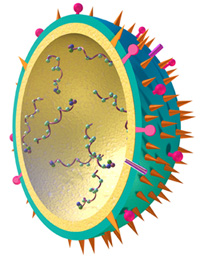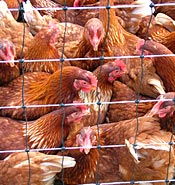Mortality Threats to Birds - Avian Influenza
Overview
Past outbreaks of the avian influenza type 'A' virus, known as H5N1 or "avian infulenza" have caused worldwide concern. All subtypes of type 'A' influenza viruses occur naturally in wild birds, particularly waterfowl, most causing little or no threat to the health of birds or people. However, H5N1 is an especially virulent and contagious strain, and was first recorded in domestic poultry in Asia. It has since spread to some wild birds in Asia and Eastern Europe. It has also infected more than 100 people and caused the deaths of 61 of them. Almost all human cases to date have been transmitted from poultry, and there have been no recorded instances of transmission from wild birds to humans.
Wild Birds and H5N1
Transmission from human to human has only been recorded in very rare cases, and in those cases the disease has not progressed past the second individual. Unless the virus mutates to be readily transmissible from human to human, the risk of a major human outbreak is low. Most human infections currently respond to drugs commonly used to treat human influenza strains, though resistance to those drugs has been recorded in Vietnam and may become a more significant factor in the future.
ABC's Position
American Bird Conservancy strongly opposes the culling of wild birds and the draining of wetlands in response to H5N1. The best science, as well as common sense, indicates that these actions are impractical, and could even result in an increase in the spread of the virus by causing birds to disperse more widely. The World Health Organization and the United Nations Food and Agriculture Organization have also taken this position.
Effective control of the disease should instead first focus on the domestic poultry industry, including: stringent global monitoring programs; immediate culling and correct disposal of infected flocks; limiting contact between domestic poultry and wild birds to limit the possible spread to wild flocks; and restrictions on the movement of domestic poultry, including banning poultry and other live bird imports and exports where needed. Because there have been recent records of cage birds transported in the international pet trade testing positive for H5N1, a ban on the trade in cage birds should be implemented to limit the spread of the virus.
ABC also supports efforts to monitor the spread of the virus in wild birds, as well as research into any differential effects across species and regions, as well as gathering more data on the ecological strategy of the virus, so that H5N1 may be more fully understood and future outbreaks prevented.
To date, H5N1 has not been recorded in North America. The observation of dead wild birds does not necessarily indicate the arrival of the virus to America, as bird deaths can be caused by a variety of diseases as well as other factors such as pesticide poisoning. Large bird die-offs should be reported to the U.S. Fish and Wildlife Service so they can investigate the exact cause. There is no evidence that feeding of wild birds plays a role in the spread of the disease, but people should clean bird feeders regularly to limit the spread of other diseases. |

 Whereas wild birds may play a role in the spread of this disease, the early spread through Asia appears to more closely track the commercial movements of domestic poultry. If migratory birds were the key factor in its movement, outbreaks could also have been expected to occur in areas where they have not yet been recorded, such as the Philippines, Taiwan, and Australia, which lie along regular migratory pathways for Asian birds. Nonetheless, recent outbreaks in China, Russia, and Eastern Europe may be linked to wild bird movements.
Whereas wild birds may play a role in the spread of this disease, the early spread through Asia appears to more closely track the commercial movements of domestic poultry. If migratory birds were the key factor in its movement, outbreaks could also have been expected to occur in areas where they have not yet been recorded, such as the Philippines, Taiwan, and Australia, which lie along regular migratory pathways for Asian birds. Nonetheless, recent outbreaks in China, Russia, and Eastern Europe may be linked to wild bird movements.